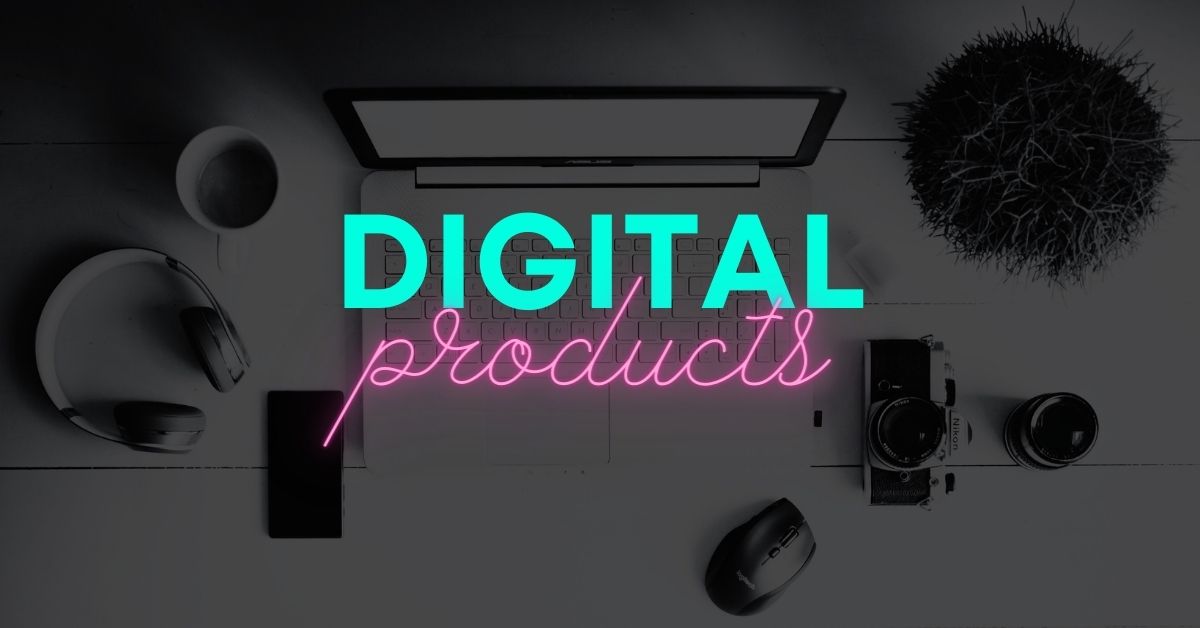Have you ever dreamed of escaping the 9-to-5 grind and building a business you love? Maybe you’ve seen other bloggers create and sell digital products, and you’re wondering if it’s possible for you too. The good news is, it absolutely is!
Digital products are the golden ticket to creating passive income, freeing up your time, and reaching a global audience. Imagine waking up to find that your online courses, ebooks, or printables have been selling while you slept – that’s the power of digital products!
Maybe you’re thinking, “I don’t have any tech skills,” or “Isn’t the market already saturated?” Don’t worry, I’m here to tell you that those are just myths. You don’t need to be a tech whiz or have a massive following to start making money with digital products.
In this comprehensive guide, I’ll walk you through everything you need to know, even if you’re a complete beginner. We’ll cover what digital products are, how to choose the right one for your audience, how to create high-quality products (even if you’re not a designer), how to price and market them effectively, and so much more.
So, are you ready to unlock the secrets to creating and selling digital products? Let’s dive in!
What Are Digital Products and Why Should YOU Sell Them?
So, what exactly are digital products? In a nutshell, they’re any product you create once and sell online repeatedly without needing to replenish inventory. Think ebooks, online courses, templates, printables, stock photos, graphics, software – the possibilities are endless!
You might be wondering, “Why should I even bother with digital products?” Well, let me tell you, they offer some amazing advantages for creators like you:
- Passive Income Potential: Imagine earning money while you sleep, travel, or simply relax. Digital products can be sold automatically, 24/7, creating a steady stream of passive income.
- Low Overhead Costs: Unlike physical products, there’s no need to worry about manufacturing, shipping, or storage. This means higher profit margins for you.
- Global Reach: You can sell your digital products to anyone, anywhere in the world, expanding your potential customer base exponentially.
- Scalability: Once your product is created, you can sell it to an unlimited number of people without any extra effort.
- Building Authority: Sharing your knowledge and expertise through digital products establishes you as an authority in your niche, attracting more followers and customers.
- Solving Problems: You can create digital products that address specific pain points for your audience, providing immense value and building trust.
Now, let’s address a couple of common misconceptions:
- Myth 1: “I don’t have any expertise to share.” Trust me, you do! We all have unique experiences, skills, or knowledge that others would find valuable. You just need to identify what makes you special and package it into a digital product.
- Myth 2: “The market is too saturated.” While it’s true that there are many digital products out there, there’s always room for fresh perspectives and new solutions. Don’t be afraid to put your own spin on things and find your niche!
If you’re looking for a way to create a sustainable online business, generate passive income, and make a real impact, then digital products are definitely worth considering.
Identifying Your Perfect Digital Product Match
Alright, now that you’re excited about the possibilities, let’s figure out which digital product is the perfect match for you and your audience. It’s kind of like online dating, but instead of finding a soulmate, you’re finding the product that will set your business heart on fire!
Finding Your Niche: It’s All About Passion and Problems
Think of your niche as your special corner of the internet where you get to shine. It’s where your passions and your audience’s needs intersect. Ask yourself:
- What topics light you up? What could you talk about for hours without getting bored? Your enthusiasm will shine through in your product and make it more engaging.
- What problems does your audience face? What keeps them up at night? What questions do they always ask you? Your digital product can be the solution they’ve been searching for.
- What unique skills or knowledge do you have? What do you know that others don’t? Your unique expertise is your secret weapon in the digital product world.
Market Research: Snoop on the Competition (and Your Audience)
Now it’s time to play detective and do some market research. This isn’t about copying others; it’s about finding inspiration and spotting opportunities.
- Check out what your competitors are offering. What types of digital products are already out there? Are there any gaps you can fill? Could you do it better?
- Survey your audience. Ask them directly what types of products they’d be interested in buying. This is the most valuable information you can get.
Choosing a Product Format: Find Your Perfect Fit
Once you have a good understanding of your niche and what your audience wants, it’s time to choose the right format for your digital product. This is where your creativity gets to shine! Some popular options include:
- Ebooks: Perfect for sharing in-depth knowledge or telling a story.
- Online courses: Great for step-by-step instruction and community building.
- Templates: Help people save time and achieve their goals.
- Printables: Fun and functional, with endless possibilities.
- Stock photos or graphics: If you’re a talented photographer or designer, this could be your niche.
- Memberships or subscriptions: Provide ongoing value and create a recurring income stream.
The best format for you depends on your skills, resources, and audience preferences. Don’t be afraid to experiment and try different things until you find what works best.
Creating High-Quality Products That Your Audience Will Love
Alright, you’ve got your brilliant idea for a digital product, but how do you actually make it a reality? Don’t worry, this isn’t as daunting as it might seem. It all starts with a plan.
Setting Realistic Goals and Timelines:
First things first, set realistic goals for yourself. How long do you realistically think it will take to create your product? Be honest with yourself and don’t try to cram everything into a weekend. Break your project down into smaller, manageable tasks, and set deadlines for each one. This will help you stay on track and avoid feeling overwhelmed.
Outlining Your Content:
Next, it’s time to outline your content. If you’re creating an ebook or course, think of it like writing a book report back in school. What are the main topics you want to cover? What are the key takeaways you want your audience to learn? Once you have a rough outline, you can start fleshing out each section with more detail.
- For ebooks and workbooks: Create a table of contents with chapters and subheadings. This will help you organize your thoughts and ensure you cover everything you want to include.
- For courses: Develop a course curriculum with modules and lessons. Each module should have a specific focus and build upon the previous one.
- For printables and templates: Sketch out your designs and consider the different variations you might offer (e.g., different sizes, colors, or themes).
Production Tips for Beginners:
Now comes the fun part – bringing your digital product to life! Don’t worry if you’re not a design pro or tech wizard. There are plenty of user-friendly tools available to help you create professional-looking products, even if you’re a beginner.
- Design Tools: Canva, Adobe Spark, or Visme for creating graphics and visuals.
- Writing and Editing Tools: Grammarly or Hemingway Editor to polish your writing.
- Course Creation Platforms: Teachable, Thinkific, or Podia to host and deliver your courses.
If you’re short on time or don’t have the skills for certain tasks, don’t hesitate to outsource! Hiring a virtual assistant, editor, or designer can be a worthwhile investment.
Quality Assurance:
Before you launch your product, it’s crucial to ensure it’s the best it can be.
- Thorough Proofreading and Editing: Ask a friend or colleague to review your work or hire a professional editor. Typos and grammatical errors can make your product look unprofessional.
- Beta Testing: Offer your product to a small group of beta testers in exchange for feedback. This can help you identify any areas that need improvement before you release it to the public.
Remember, creating a high-quality digital product is an investment in your business and your audience. By taking the time to create something valuable, you’ll build trust with your customers and increase your chances of success.
Pricing Your Digital Products – Finding the Sweet Spot
Alright, you’ve poured your heart and soul into creating an amazing digital product – now it’s time to decide how much to charge for it. This can feel a little daunting, but I’m here to guide you through it.
There’s no one-size-fits-all answer when it comes to pricing digital products. It’s a balancing act, but there are some key factors to consider:
- Value Provided: Think about the transformation your product offers. How much would your ideal customer pay to solve the problem your product addresses or achieve the results it promises? This is where understanding your target audience is crucial.
- Production Costs: Did you invest in any software, courses, or other resources to create your product? Be sure to factor those costs into your pricing.
- Competitor Pricing: Take a peek at what others in your niche are charging for similar products. This will give you a ballpark idea of what the market will bear.
- Your Target Audience’s Budget: Who are you trying to reach? Are they budget-conscious students or high-earning professionals? Adjust your pricing accordingly.
Now, let’s explore a few pricing strategies that can help you maximize your digital product sales:
- Tiered Pricing: Offer different levels of your product at different price points. This gives your customers more options and can increase your overall revenue.
- Bundle Deals: Combine multiple products or services into a package deal at a discounted price. This can incentivize customers to buy more.
- Introductory Discounts: Offer a special price for a limited time to attract early adopters and generate buzz.
Remember, pricing is not set in stone. You can always adjust your prices later based on customer feedback and sales data. The most important thing is to choose a pricing strategy that aligns with your goals and values.
Marketing and Selling Your Digital Products: Get Your Products Seen and Make Sales
Okay, you’ve poured your heart and soul into creating amazing digital products. Now comes the fun part: getting them out into the world! But how do you actually make sales? Let’s break down the marketing and sales strategies that will get your products noticed and flying off the virtual shelves.
Building Your Email List: Your Secret Weapon for Digital Product Sales
Your email list is your most valuable asset as a digital product creator. It’s a direct line to your most engaged audience – people who are genuinely interested in what you have to offer. Here’s how to build your list:
- Create Lead Magnets: These are irresistible freebies (like checklists, templates, or mini-courses) that people exchange their email address for. Make sure your lead magnets are relevant to your digital products and offer real value.
- Promote Your List: Add opt-in forms to your blog, website, and social media profiles. Use pop-ups, slide-ins, or even dedicated landing pages to encourage sign-ups.
- Nurture Your Subscribers: Send regular emails with valuable content, exclusive offers, and sneak peeks of upcoming products. Build a relationship with your audience so they’ll be eager to support you.
Creating a Sales Page That Converts: Turn Visitors into Customers
Your sales page is where the magic happens – it’s where potential customers decide whether or not to buy your digital product. Here’s how to create a sales page that converts:
- Write Compelling Copy: Use persuasive language that highlights the benefits of your product and addresses your audience’s pain points. Tell a story, share testimonials, and create a sense of urgency.
- Use High-Quality Visuals: Include eye-catching images, videos, or graphics that showcase your product and make it look irresistible.
- Offer a Money-Back Guarantee: This reduces risk for potential customers and builds trust in your product.
Promoting Your Product: Spread the Word Far and Wide
Once your sales page is up and running, it’s time to get the word out! Here are some effective ways to promote your digital products:
- Social Media Marketing: Share engaging posts, run contests, and leverage paid advertising (like Facebook Ads or Instagram Ads) to reach a wider audience.
- Email Marketing: Send targeted email campaigns to your list, highlighting the benefits of your product and offering exclusive discounts.
- Collaborations and Partnerships: Partner with other bloggers or influencers in your niche to cross-promote each other’s products.
- Paid Advertising (Optional): Consider investing in paid advertising platforms like Google Ads or Pinterest Ads to reach potential customers who are actively searching for products like yours.
Remember, promoting your digital products is an ongoing process. Don’t be afraid to experiment with different strategies to find what works best for your audience and your budget.
Your Burning Questions About Selling Digital Products – Answered!
So, you’re excited about the possibilities of digital products, but you probably have a few questions. Don’t worry, you’re not alone! Let’s tackle some of the most common concerns I hear from aspiring digital product creators:
Q: How do I protect my products from being copied or shared illegally?
A: While it’s impossible to completely eliminate piracy, you can take steps to deter it. Using password protection, watermarks, and clearly stating your copyright terms can help. Some platforms also offer built-in security features for digital downloads.
Q: Do I need a fancy website to sell my products?
A: Nope! While having your own website can be beneficial, it’s not a necessity when you’re just starting out. Many platforms like Etsy, Shopify, or even social media can be great places to launch your digital products.
Q: How much should I charge for my products?
A: Pricing is a balancing act. You want to price your products high enough to reflect their value but also make them accessible to your target audience. Consider factors like your production costs, the value your product provides, and what your competitors are charging.
Q: What if I don’t have a huge audience? Can I still make money?
A: Absolutely! You don’t need thousands of followers to start selling digital products. Focus on building an engaged email list, creating high-quality products that solve real problems, and promoting them strategically to reach your ideal customers.
Q: What tools do I need to create digital products?
A: The good news is you don’t need a lot of fancy software! Many free or affordable tools can help you create beautiful and professional-looking digital products. For example, Canva is great for designing ebooks and printables, while Teachable or Thinkific are popular platforms for hosting online courses.
Q: I’m not an expert. Do I still have something valuable to share?
A: Yes, you do! Everyone has unique experiences and knowledge that can be valuable to others. Don’t underestimate the power of your own story and expertise. You might be surprised at how many people are eager to learn from you!
Have more questions? Don’t hesitate to ask in the comments below! I’m always happy to help.
Congratulations! You’ve made it to the end of this comprehensive guide on how to make money selling digital products. You’re now armed with the knowledge and tools to turn your passion into profit and build the online business of your dreams.
Remember, the beauty of digital products is their flexibility and potential for passive income. Whether you’re a seasoned blogger or just starting out, there’s a digital product out there waiting to be created by you.
So, what are you waiting for? Start brainstorming your next digital product idea, create something amazing, and share it with the world! Don’t be afraid to experiment, learn as you go, and most importantly, have fun along the way.
And hey, if you have any questions or want to share your success stories, I’d love to hear from you. Drop a comment below – let’s connect and build a thriving community of digital creators!









People reacted to this story.
Show comments Hide commentsthat is cool
I’m glad you think so. Let me know if there is anything I can help you with.